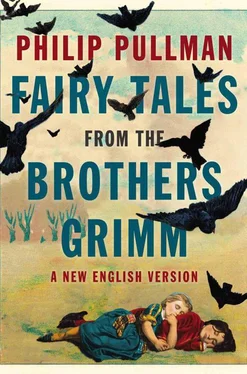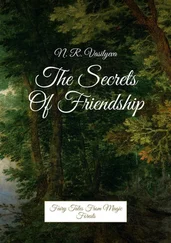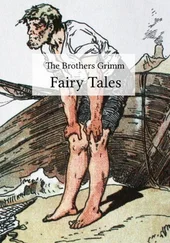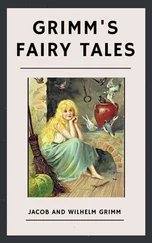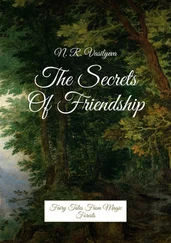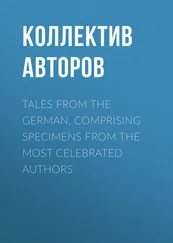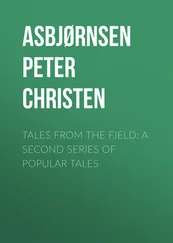‘Oh, what a pity,’ said the old woman. ‘They taste so good, too. Look, I’ll take a bite in case you’re worried.’
She had made the apple so cunningly that only the red half was poisoned. Of course she took a bite from the white half, and then held it out to Snow White.
It looked so delicious that the poor girl couldn’t resist. She reached out through the window, took the apple, and bit deeply into the red part, and she’d hardly bitten off a piece when she fell to the floor, dead.
The wicked queen leaned in and saw her lying on the floor, and she laughed a loud laugh.
‘White as snow, red as blood, black as ebony! And now dead as a doornail! Those little monkeys won’t wake you up this time.’
When she got back to her boudoir she asked the mirror:
‘Mirror, mirror on the wall,
Who in this land is the fairest of all?’
And the mirror answered:
‘Your majesty, you are the fairest of all.’
She sighed a deep and happy sigh of satisfaction. If an envious heart can be at rest, hers was then.
When the dwarfs came home that evening, they found Snow White on the floor, stark and still. She wasn’t breathing, her eyes were closed, she wasn’t moving at all. She was dead. They looked around for whatever might have killed her, and found nothing; they unfastened her laces in case she couldn’t breathe; they looked through her hair for a poisoned comb; they warmed her by the fire, they put a drop of brandy on her lips, they laid her on a bed and they sat her up in a chair, but nothing helped.
Then it struck home to them that she must be really dead, and they laid her out gently on a bier and sat beside her, weeping for three days. They had intended to bury her, but she still looked so fresh and beautiful, just as if she was only sleeping, that they couldn’t bring themselves to put her under the black earth.
So they had a glass coffin made, and laid her inside. With letters of gold they wrote ‘PRINCESS SNOW WHITE’ on it, and they carried it up to a mountain top. From then on one of the dwarfs stayed beside her all the time. They took it in turns to watch over her, and the birds came and mourned for her as well: first an owl, then a raven, and finally a dove.
And so things remained for a long, long time. The body of Snow White did not decay, for she still looked as white as snow, as red as blood and as black as ebony.
One day a prince happened to be hunting in the forest, and he came to the dwarfs’ house and asked for shelter for the night. Next morning he saw the sunlight glitter on the mountain top and went to see what was there. He found the glass coffin, he read the golden inscription, and he saw the body of Snow White.
He said to the dwarfs, ‘Let me take the coffin away with me. I’ll pay you as much as you want.’
‘We don’t want money,’ they said. ‘We wouldn’t sell that coffin for all the money in the world.’
‘Then please give it to me,’ he begged. ‘I’ve fallen in love with Princess Snow White, and I can’t live without being able to see her. I’ll treat her with all the honour and respect I’d feel for a living princess.’
The dwarfs went away a little and spoke together quietly. Then they came back and said they’d taken pity on him, and they were sure he’d treat their dear Snow White properly, so he could take her back to his kingdom.
The prince thanked them and told his servants to pick up the coffin with great care and carry it along with him. But as they were going down the mountainside, one of the servants tripped and stumbled, and shook the coffin; and that dislodged the piece of apple from Snow White’s throat, for she had never quite swallowed it.
And slowly she woke up, and then she pushed open the lid of the coffin and sat up, fully alive once more.
‘Dear God, where am I?’ she said.
The prince said joyfully, ‘You’re with me!’ He told her everything that had happened, and then said, ‘I love you more than anything else in the world. Come with me to my father’s castle, and become my wife.’
Snow White loved him at once, and their wedding was arranged with great splendour and magnificence.
Among the guests invited to the ceremony was Snow White’s wicked stepmother. After putting on the most beautiful of her dresses she stood in front of the magic mirror and said:
‘Mirror, mirror on the wall,
Who in this land is the fairest of all?’
And the mirror answered:
‘Your majesty, you are still lovely, it’s true,
But the young queen’s a thousand times fairer than you.’
The queen gasped with horror. She was so frightened, so terrified, that she didn’t know what to do. She didn’t want to go to the wedding and she didn’t want to stay away, and yet she felt she had to go and see the young queen; so in the end she went. And when she saw Snow White she recognized her at once, and was struck with horror. She could only stand there trembling.
But a pair of iron shoes had already been placed in the fire. When they were red-hot they were brought out with tongs and placed on the floor. And the wicked queen was made to step into them, and dance till she fell down dead.
* * *
Tale type:ATU 709, ‘Snow White’
Source:a story told to the Grimm brothers by the Hassenpflug family
Similar stories:Katharine M. Briggs: ‘Snow-White’ ( Folk Tales of Britain ); Italo Calvino: ‘Bella Venezia’, ‘Giricoccola’ ( Italian Folktales )
The great gravitational attraction of Walt Disney’s Snow White and the Seven Dwarfs will always pull at this tale, unless the storyteller simply decides to ignore it, which isn’t actually very hard to do, if you take your lead from Grimm.
Disney was a great storyteller, though, and it’s interesting to see how the artists in the Disney studio, working under his direction, focused not only on one aspect of the tale that is in Grimm (the wickedness of the stepmother/queen) but also on another that isn’t (the comedy of the dwarfs, their individual names and personalities). ‘Work to your strengths’ is a good storytelling maxim. The Disney corporation was very good at visual gags and the easily read charm of little children, which are embodied in the forest animals (big eyes, simple trusting natures, round bodies) and in the dwarfs, who are toddlers with beards.
And I am all in favour stealing anything that works. What works in one medium won’t necessarily work in another, though, and I don’t think characterizing each separate dwarf works at all off the screen. They don’t function like that in Grimm: here they are a band of little earth-spirits, benevolent and anonymous. They are perfectly capable of looking after themselves, unlike the bearded babies of Disney, who have to be cooked for and cleaned up after by Snow White the all-American mom.
In both Disney and Grimm they can mourn Snow White but they can’t bring her back to life. Only a happy accident, engineered by a prince, can do that.
In the Grimms’ first edition, of 1812, the wicked queen was Snow White’s mother. She didn’t become a stepmother until the second edition of 1819, when Snow White’s mother died in childbirth. What happened to her father? Dim, faint and sketchy, like many of the males in Grimm, he was simply obliterated by the power of the monstrous queen.
TWENTY-SEVEN
RUMPELSTILTSKIN
There was once a poor miller who had a beautiful daughter. One day he happened to fall into conversation with the king, and in order to impress him he said, ‘You know, your majesty, I have a daughter who can spin straw into gold.’
Читать дальше
